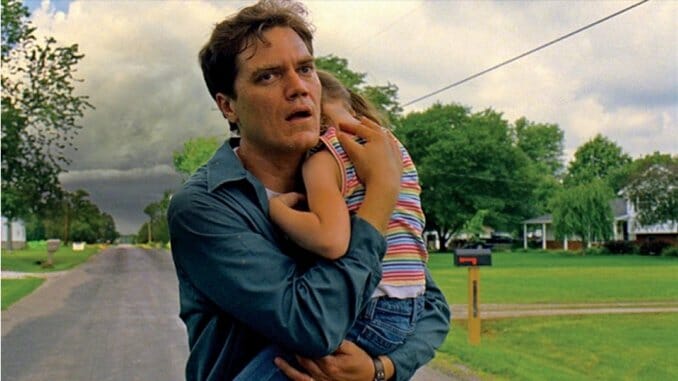Take Shelter, the new film by Jeff Nichols, opens with an ominous dream. Though the exact cause of the threat is veiled, its manifestations are not—the wind blows, a massive storm front approaches and a viscous fluid that’s definitely not rain begins to fall. For Curtis (Michael Shannon), the dream leaves a lasting impression even as he attempts to shake it off and meet his responsibilities as a husband, father and blue-collar working man.
As the intensity of his dreams (and visions) increases, Curtis faces two equally dire possibilities: either he’s succumbing to some form of mental illness or the portents are real. The former worries him almost as much as the latter, as he’s now roughly the same age as his mother (played with pitch-perfect presence by Kathy Baker) when she abandoned him as the result of a mental breakdown. To his credit, Curtis strives to address both possibilities simultaneously—embarking on an obsessive (and expensive) expansion of the backyard tornado shelter while also attempting to either personally or professionally diagnose his possible mental affliction. His escalating efforts threaten to compromise his job, his marriage and his societal standing even as the visceral impact of the visions continues to mount.
Take Shelter is built on deliberate pacing and deliberately restrained performances. As such, the acting is crucial, the difference between being nod-worthy or nodding-off-worthy. Fortunately, both Michael Shannon and Jessica Chastain (as Curtis’ wife, Samantha) are riveting as a loving couple whose relationship comes under sudden, pronounced strain. Purposefully given very little to work with in terms of scripted embellishment—Curtis spends half his screen time looking at things, thinking about things and uttering monosyllabic responses concerning things—Shannon’s performance as a tortured everyman is eye-opening. It should at the least get him a seat and video close-up or two in Los Angeles’ Kodak Theater come February.
Shannon, Chastain and Baker are not the only standouts. Take Shelter represents a long overdue re-grounding of the “grand threat drama” into the intensely personal dilemma, and the film’s entire cast, along with the direction of Nichols, plays an important role in that grounding. Too often, films set in non-urban locales are just a collection of clichés delivered by actors who are either too polished or too preciously unpolished. In Take Shelter, the situations, reactions and interactions possess a palpable real-world feel. It’s almost as if some stretches are just documentary footage seamlessly spliced into the whole. This is especially impressive in a film where a primary, recurring component—the apocalyptic visions—must be nested realistically within a greater whole.
With this organic feel, Take Shelter seems almost old-fashioned in an era where any film with an apocalyptic theme—whether the threat is real or not—seems derived from the same set of pre-erected dominoes, waiting to be toppled. (Cue string of set-piece Portents. Follow directly with barrage of set-piece Action Sequences. Score overbearing soundtrack accordingly. Oh, and tell Mr. Cusack we’re ready to shoot his next scene.) But if Signs, 2012 and the like set about to achieve their effects through a dramatic pounding on the keys, Take Shelter is a sequence of lightly touched notes that weaves in and out of hearing, only occasionally rising to a crescendo. As a result, in only his second film, Nichols achieves a lasting resonance with the audience that is rarely found in the works of much more experienced directors.
By film’s end, Take Shelter will remind many viewers—to an uncomfortable degree, even—of how saturated most lives are with latent, or blatant, anxiety. One need not be prone to apocalyptic visions to catch glimpses each day of the life-shattering—or at least life-overturning—events that lurk around every corner as one strives to provide for self and loved ones. Even modestly robust financial security can be wiped away by physical or mental illness, by mishap or misjudgment in or beyond one’s control. On a more metaphysical level, there are the threatening upheavals of self—failures to be the parent, spouse, worker or friend one should be.
It’s in how one navigates these perceived perils—the rocks and hard places strewn throughout our daily lives—that will determine, at least to some extent, the truths behind the visions that threaten to engulf us. Or, to paraphrase the dialogue during one of the most memorable moments of Take Shelter, when faced with that which terrifies us, it’s how we decide to stay that matters.
